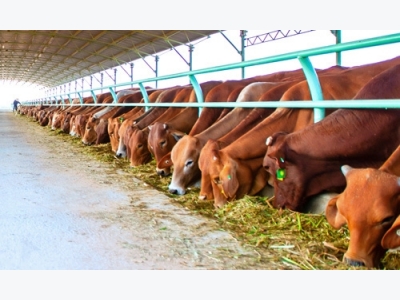Imports driving Vietnam cattle farmers out of business

Vietnamese beef is having a difficult time competing with imported beef. Photo by VnExpress
Dealers are putting pressure on local farmers to sell their cows at a low price because of abundantly available imported beef.
Vietnamese beef prices have been falling because of a market glut, while imported beef is flexing its competitive muscles, offering higher quality for similar prices.
In the central province of Ninh Thuan, dealers are buying a head of cattle from farmers for just VND7-8 million ($304.3-347.8), a third of the VND20-21 million price it fetched two years ago.
Dealers in the southern province of Soc Trang province are also giving farmers a hard time, buying beef at VND40,000 per kilogram, 40 percent of the price in 2016.
“I have never seen beef prices so low,” livestock farmer Lam Sanh said, adding that he might have to quit and find another way to make a living.
With prices falling over the last two years, small-scaled cattle farmers have been switching to different vocations, a husbandry official in An Giang province said.
The number of cows and buffaloes raised in Vietnam has fallen to five million now from nearly seven million in 2006, according to the Vietnam Animal Husbandry Association.
Vietnamese beef is having a difficult time competing with imported beef, which comes in abundance and is priced reasonably, Tong Xuan Chinh, deputy head of the Animal Husbandry Department told the Tuoi Tre newspaper.
Last year, the country imported more than 262,300 heads of cattle, and nearly 42,000 tons of beef and buffalo meat, valued at more than $410 million, according to the Animal Husbandry Department under the Ministry of Agriculture and Rural Development.
Dealers are putting pressure on farmers to sell their cows at a low price because beef imported from the U.S. and Australia are abundantly available in supermarkets and sold at the same price as local beef at VND250,000–400,000.
At this price, imported beef is being favored by consumers concerned about safety issues that have plagued the Vietnamese food market in recent years.
The Vietnamese government has issued policies to assist local cattle farmers but these have not led to raising the scale of production and ability to provide better quality at lower prices.
“The competition between local beef and imported beef will continue to be intense,” Chinh said.
Có thể bạn quan tâm
 Quang Tri lures investment in hi-tech agriculture
Quang Tri lures investment in hi-tech agriculture The central province of Quang Tri has recently drawn many investment projects in hi-tech and organic agriculture, contributing to restructuring the agricultural
 Vietnam’s rice exports surge 42% in first half of 2018
Vietnam’s rice exports surge 42% in first half of 2018 Rice exports brought in US$1.81 billion for Vietnam in the first six months of 2018, up 42% over the same period last year
 Dong Thap strives to turn mango into key export product
Dong Thap strives to turn mango into key export product The Mekong Delta province of Dong Thap, the largest mango producer in the region with 9,200 hectares of mangos and a annual output of nearly 100,000 tonnes